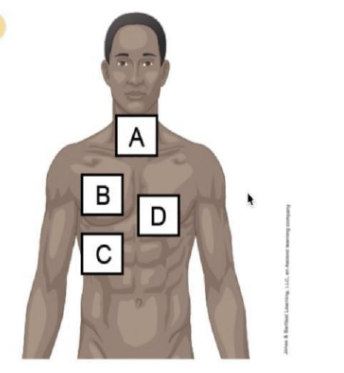ATI RN
RN-ATI-Fundamentals-of-Nursing-2023-2024 Questions
Extract:
Question 1 of 5
nurse is auscultating for crackles on a client who has pneumonia. Which of the following anterior chest wall locations should the nurse auscultate? (You will find hot spots to select in the artwork belowi. Select only the hot spot that corresponds to your answer.)

Correct Answer:
Rationale:
Correct
Answer: B
Rationale: Crackles in pneumonia are typically heard in the lower lung fields due to fluid accumulation. Auscultating at location B (lower anterior chest wall) allows for better detection of crackles in the bases of the lungs where pneumonia commonly affects. This area corresponds to the lower lobes where consolidation occurs, leading to crackles. Auscultating at other locations (A, C,
D) may not yield clear crackle sounds associated with pneumonia.
Summary of other choices:
A (Location A - upper anterior chest wall): Crackles in pneumonia are typically heard in the lower lung fields due to fluid accumulation.
C (Location C - middle anterior chest wall): Crackles in pneumonia are not typically heard in the middle lung fields.
D (Location D - upper lateral chest wall): Crackles in pneumonia are not typically heard in the upper lateral chest wall.
Extract:
urses' Notes 0900:
Client reports a 3-month history of intermittent diarrhea and abdominal pain. Reports unintentional weight loss of 5.5 kg (12~O Ib)in 3 months.
0930:Stool sample obtained for fecal occult blood test. Fatty appearance and foul odor noted.
Question 2 of 5
For each assessment finding, click to specify if the finding is consistent with ulcerative colitis, diverticulitis, or Crohn’s disease.
| Assessment | Ulcerativecolitis | Diverticilis | Crohn'sdisease |
|---|---|---|---|
| Fever | |||
| Steatorrhea | |||
| Anemia | |||
| Weight loss | |||
| Diarrhea |
Correct Answer: A, B, C, D
Rationale:
To determine which assessment findings are consistent with ulcerative colitis, diverticulitis, or Crohn's disease, we need to analyze the characteristics of each condition.
1. Fever : This finding can be seen in all three conditions, but it is more commonly associated with Crohn's disease due to the inflammatory nature of the disease.
2. Steatorrhea (
B): This is a common symptom of Crohn's disease due to malabsorption issues, making it a key indicator for this condition.
3. Anemia (
C): Anemia is a common complication of inflammatory bowel diseases like ulcerative colitis and Crohn's disease, often related to chronic inflammation and blood loss.
4. Weight loss (
D): This is a common feature of all three conditions due to malabsorption, decreased appetite, and chronic inflammation.
Therefore, the correct answer is A, B, C, D as these findings are consistent with all three conditions. Diarrhea (E
Extract:
Client presents today for an annual examination. Reports [ackof [ Adminscer an arcibese medication. sleep and increased stress due to moving and starting a new ke fob. ) Adminsceran arcinypercensive medicatn. Today, 1400: [ Lot foods bigh mporassurs.
Client presents to office today with reports of fatigue. Client states that they have difficulty sleeping without drinking four o five beers a night. Client reports, "I sometimes get headaches alana with naiicas and uamiting
Question 3 of 5
The nurse is planning care for the client. Which of the following prescriptions should the nurse anticipate the provider to prescribe?
Correct Answer: A,D,E
Rationale: The correct answers are A, D, and E. A - Limiting alcohol intake reduces the risk of adverse health effects. D - A 2,300 mg sodium diet is beneficial for managing blood pressure. E - Antihypertensive medication helps control high blood pressure. B and F are not directly related to planning care for the client. C may not be necessary unless there is an infection present.
Extract:
Question 4 of 5
A nurse is reinforcing teaching with a client who has hypertension and a prescription to measure her blood pressure daily. Which of the following client statements indicates an understanding of the teaching?
Correct Answer: C
Rationale: The correct answer is C: "I should remove constrictive clothing prior to measuring my blood pressure." Removing constrictive clothing ensures accurate blood pressure measurement by allowing the cuff to fit properly on the arm without any restrictions, leading to a more reliable reading.
Choice A is incorrect as coffee can temporarily increase blood pressure.
Choice B is incorrect because the arm should be at heart level, not elevated.
Choice D is incorrect as blood pressure should be measured on an empty stomach for accuracy.
Question 5 of 5
A nurse is reinforcing teaching about advance directives with a client who has end-stage renal disease. Which of the following client statements indicates an understanding of the teaching?
Correct Answer: A
Rationale:
Rationale: Option A is correct because it shows the client understands that advance directives can be modified. This is crucial as preferences may change over time. Option B is incorrect as the healthcare proxy only makes decisions when the client cannot. Option C is incorrect as the healthcare proxy's decisions are legally binding. Option D is incorrect because advance directives must comply with state laws and may not be universally recognized.
